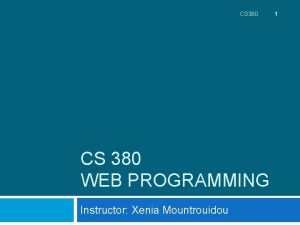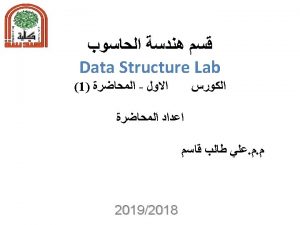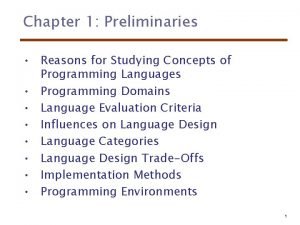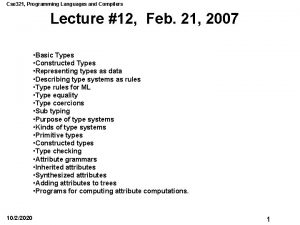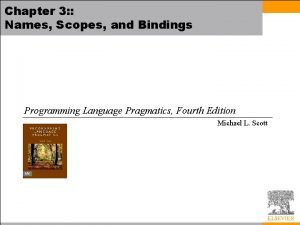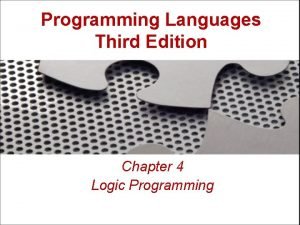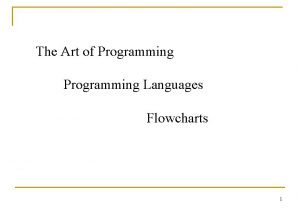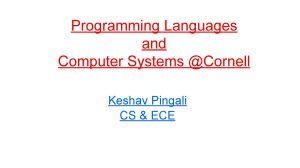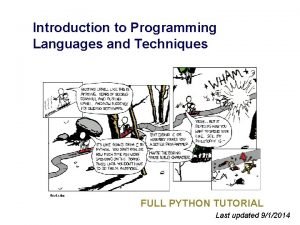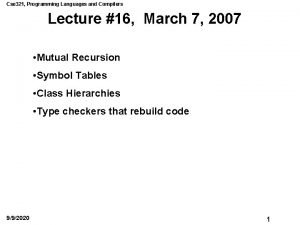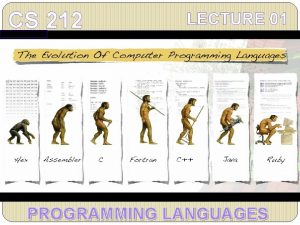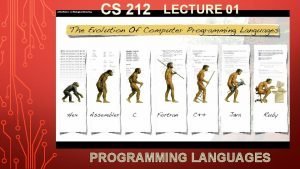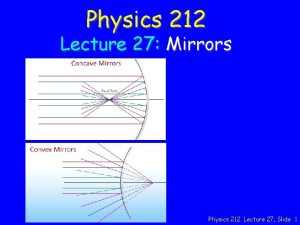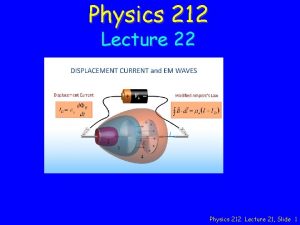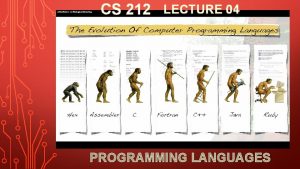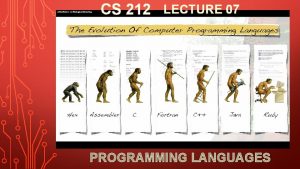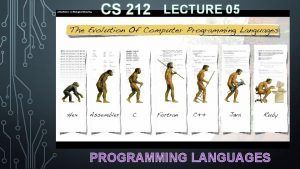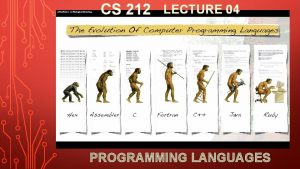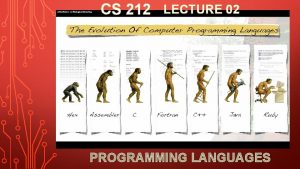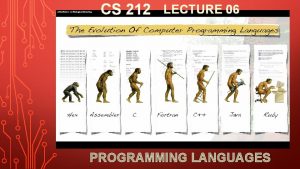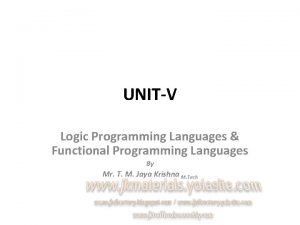CS 212 LECTURE 01 PROGRAMMING LANGUAGES CS 212





















- Slides: 21

CS 212 LECTURE 01 PROGRAMMING LANGUAGES

CS 212 Programming Languages Instructor : Somchai Thangsathityangkul You can download lecture note at http: //kbucomsci. weebly. com/ 2 Class Presence 10% Quiz 20% Homework 10% Midterm 20% Final 40% Total 100%

The Top Programming Languages 2018 3

Reasons for Studying Concepts of Programming Languages �Increased ability to express ideas �Improved background for choosing appropriate languages �Increased ability to learn new languages �Better understanding of significance of implementation �Increased ability to design new languages 4

Programming Domains �Scientific applications �Large number of floating point computations �Fortran �Business applications �Produce reports, use decimal numbers and characters �COBOL �Artificial intelligence �Symbols rather than numbers manipulated �LISP �Systems programming �Need efficiency because of continuous use �C �Web Software �Electic collection of languages: markup (e. g. , XHTML), scripting (e. g. , PHP), general-purpose (e. g. , Java) 5

Language Evaluation Criteria �Readability: the ease with which programs can be read and understood �Writability: the ease with which a language can be used to create programs �Reliability: conformance to specifications (i. e. , performs to its specifications) �Cost: the ultimate total cost 6

Influences on Language Design �Computer Architecture �Languages are developed around the prevalent computer architecture, known as the von Neumann architecture �Programming Methodologies �New software development methodologies (e. g. , object-oriented software development) led to new programming paradigms and by extension, new programming languages 7

Computer Architecture Influence �Well-known computer architecture: Von Neumann �Imperative languages, most dominant, because of von Neumann computers �Data and programs stored in memory �Memory is separate from CPU �Instructions and data are piped from memory to CPU 8

Programming Methodologies Influences � 1950 s and early 1960 s: Simple applications; worry about machine efficiency �Late 1960 s: People efficiency became important; readability, better control structures �structured programming �top-down design and step-wise refinement �Late 1970 s: Process-oriented to data-oriented �data abstraction �Middle 1980 s: Object-oriented programming �Data abstraction + inheritance + polymorphism 9

Language Categories �Imperative �Central features are variables, assignment statements, and iteration �Examples: C, Pascal �Functional �Main means of making computations is by applying functions to given parameters �Examples: LISP, Scheme �Logic �Rule-based (rules are specified in no particular order) �Example: Prolog �Object-oriented �Data abstraction, inheritance, late binding �Examples: Java, C++ �Markup �New; not a programming per se, but used to specify 10 the layout of information in Web documents �Examples: XHTML, XML

Imperative Languages �Example: a factorial function in C int fact(int n) { int sofar = 1; while (n>0) sofar *= n--; return sofar; } 11

Functional Languages �Example: a factorial function in ML fun fact x = if x <= 0 then 1 else x * fact(x-1); �Example: a factorial function in Lisp (defun fact (x) (if (<= x 0) 1 (* x (fact (- x 1))))) 12

Implementation Methods �Compilation �Programs are translated into machine language �Pure Interpretation �Programs are interpreted by another program known as an interpreter �Hybrid Implementation Systems �A compromise between compilers and pure interpreters 13

Layered View of Computer The operating system and language implementation are layered over Machine interface of a computer 14

Compilation �Translate high-level program (source language) into machine code (machine language) �Slow translation, fast execution �Compilation process has several phases: �lexical analysis: converts characters in the source program into lexical units �syntax analysis: transforms lexical units into parse trees which represent the syntactic structure of program �Semantics analysis: generate intermediate code �code generation: machine code is generated 15

The Compilation Process 16

Pure Interpretation �No translation �Easier implementation of programs (run-time errors can easily and immediately displayed) �Slower execution (10 to 100 times slower than compiled programs) �Often requires more space �Becoming rare on high-level languages �Significant comeback with some Web scripting languages (e. g. , Java. Script) 17

Pure Interpretation Process 18

Hybrid Implementation Systems �A compromise between compilers and pure interpreters �A high-level language program is translated to an intermediate language that allows easy interpretation �Faster than pure interpretation �Examples �Perl programs are partially compiled to detect 19 errors before interpretation �Initial implementations of Java were hybrid; the intermediate form, byte code, provides portability to any machine that has a byte code interpreter and a run-time system (together, these are called

Hybrid Implementation Process 20

Just-in-Time Implementation Systems �Initially translate programs to an intermediate language �Then compile intermediate language into machine code �Machine code version is kept for subsequent calls �JIT systems are widely used for Java programs �. NET languages are implemented with a JIT system 21
 01:640:244 lecture notes - lecture 15: plat, idah, farad
01:640:244 lecture notes - lecture 15: plat, idah, farad Cse 340 principles of programming languages
Cse 340 principles of programming languages Xenia programming languages
Xenia programming languages Joey paquet
Joey paquet Middle level programming languages
Middle level programming languages Reasons for studying concepts of programming languages
Reasons for studying concepts of programming languages Programming languages
Programming languages Transmission programming languages
Transmission programming languages Cxc it
Cxc it Storage management in programming languages
Storage management in programming languages Real time programming language
Real time programming language Programing languages
Programing languages Comparative programming languages
Comparative programming languages Real-time systems and programming languages
Real-time systems and programming languages Programming languages flowchart
Programming languages flowchart Cornell programming languages
Cornell programming languages Language
Language Adam doupe cse 340
Adam doupe cse 340 Advantages of high level language
Advantages of high level language Introduction to programming languages
Introduction to programming languages Xkcd software development
Xkcd software development Programming languages
Programming languages


